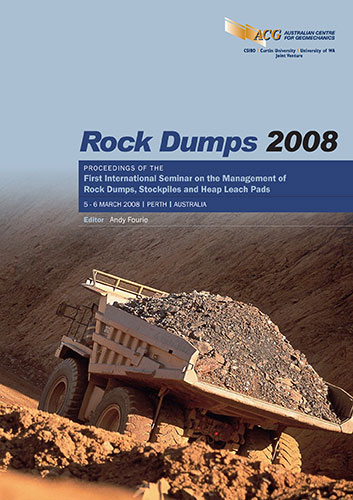A Logical Framework for the Design, Construction, and Rehabilitation of Mine Site Waste Rock Dumps

|
Authors: Loch, RJ; Lowe, SM |
DOI https://doi.org/10.36487/ACG_repo/802_22
Cite As:
Loch, RJ & Lowe, SM 2008, 'A Logical Framework for the Design, Construction, and Rehabilitation of Mine Site Waste Rock Dumps', in AB Fourie (ed.), Rock Dumps 2008: Proceedings of the First International Seminar on the Management of Rock Dumps, Stockpiles and Heap Leach Pads, Australian Centre for Geomechanics, Perth, pp. 257-2265, https://doi.org/10.36487/ACG_repo/802_22
Abstract:
Waste rock dumps are a major consequence of many mining operations. Government, community and stakeholder expectations for the rehabilitation of waste rock dumps are continuing to evolve. This places increasing pressure on companies to ensure that their “waste disposal” is as cost-effective as possible, with concerns not only for initial costs, but also for the costs of repair of remediation failures. Pending changes to guidelines for Environmental Performance Bonds for waste rock dumps in Western Australia are expected to adopt a risk-based assessment of the landforms to set bond levels. While such bond guidelines could obviously increase the bond held over high-risk landforms, it could also create potential for well-designed and well-constructed waste rock dumps to be subject to lower levels of bond, further increasing economic incentives for companies to adopt waste rock dump design and construction procedures that will consistently deliver quality, cost-effective results. This paper outlines (with examples from a number of sites) a framework covering the various stages in design, construction, and rehabilitation of a waste rock dump. Properly applied, the framework can deliver consistent reductions in risk of failure, and dramatic improvements in cost-effectiveness. Based on the key performance indicator (KPI) approach developed at Minara Resources’ Murrin Murrin Nickel Operation (Loch et al., 2006), the framework specifies stages of planning, construction, and rehabilitation, and identifies the range of actions necessary within each stage. The framework is distinctive for its emphasis on quality control during waste rock dump construction, but this aspect of waste rock dump construction is crucial to achievement of a quality outcome. Similarly, the framework specifies a range of actions for planning and executing dump rehabilitation works.
References:
Landloch Pty Ltd (2006) Generic Concave Slope Profiles for Constructed Landforms, Murrin Murrin Nickel Operation,
not Published.
Landloch Pty Ltd (2005) Field rainfall simulator and overland flow study of batter slope erodibility: development of
stable slope profiles for Minara Resources Murrin Murrin Operations, not Published.
Landloch Pty Ltd (2004) Erodibility of materials from Murrin Murrin Operation, Minara Resources: Results of
laboratory studies, and computer simulations to design stable batter slopes for waste dumps, not Published.
Landloch Pty Ltd and Rally Revegetation and Environmental Services (2004) Rehabilitation and Stability Assessment
of Landforms at Murrin Murrin, Not Published.
Loch, R., Stevens, T., Wells, G. and Gerrard, R. (2006) Development of key performance indicators for rehabilitation,
Murrin Murrin Operation. Fourie, A.B. and Tibbett, M. (editors), Proceedings First International Seminar on
Mine Closure, 13-15 September 2006, Perth, Australian Centre for Geomechanics, pp. 569-576.
Minara Resources (2005) Environmental Management Plan For Murrin Murrin Operations Pty Ltd, Minara Resources.
Stingemore, M. (2007) Rehabilitation Management Plan – Waste Dumps, Minara Environment Department, pp. 34-35,
not Published.
Taylor, G.A., Spain, A., Nefiodovas, A., Timms, G., Kuznetsov, V. and Bennett, J. (2003) Determination of the
Reasons for Deterioration of the Rum Jungle Waste Rock Cover.
Vacher, C.A., Loch, R.J. and Raine, S.R. (2004). Identification and Management of Dispersive Mine Spoils Report.
Closure and Environmental Impacts
Rock Dumps 2008, Perth, Australia 265
© Copyright 2025, Australian Centre for Geomechanics (ACG), The University of Western Australia. All rights reserved.
View copyright/legal information
Please direct any queries or error reports to repository-acg@uwa.edu.au
View copyright/legal information
Please direct any queries or error reports to repository-acg@uwa.edu.au